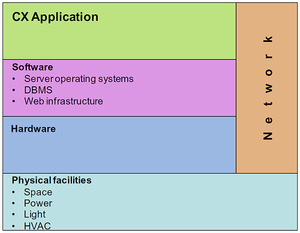Comparing Deployment Options for CX Apps
On-Premise, Hosted Single-Tenant, and Hosted Multi-Tenant
CX application suppliers offer three deployment approaches: on-premise, hosted single-tenant, and hosted multi-tenant. Hosted multi-tenant deployments offer huge advantages and benefits over the two alternatives. As significantly, hosted multi-tenant offerings now have the rich and flexible functionality that can address your requirements to support your customers’ activities. And, most on-premise CX application suppliers have brought or are bringing hosted multi-tenant versions of their offerings to market.
NETTING IT OUT
CX application suppliers offer three deployment approaches: on-premise, hosted single-tenant, and hosted multi-tenant.
Hosted multi-tenant —sometimes called SaaS—is a deployment where you and all the rest of your hoster's customers implement the application in your hoster's shop, on your IT resources, and your hoster supports and manages all its customers' implementations for availability, performance, scalability, and new software releases.
Hosted multi-tenant deployments offer huge advantages and benefits over the two alternatives:
- Lower licensing fees and better timing for license fee payment.
- Elimination of your responsibility and risk in planning for, selecting, purchasing, and maintaining the IT resources to support your CX apps.
- Elimination of your responsibility for managing availability, performance, and scalability.
- Reduction in your effort, staff, and skill to install and support CX apps.
As significantly, hosted multi-tenant offerings now have the rich and flexible functionality that can address your requirements to support your customers' activities. And most on-premise CX application suppliers have brought, or are bringing, hosted multi-tenant versions of their offerings to market.
CX Deployment Environment
© 2009 Patricia Seybold Group
Illustration 1. In this Illustration we show the components of the CX Deployment Environment
THREE DEPLOYMENT APPROACHES
Customer experience (CX) application suppliers offer three approaches for your deployment of their ecommerce, customer service, and campaign management offerings:
- On-premise
- Hosted single-tenant
- Hosted multi-tenant
We feel very strongly that application functionality should be the top criterion in your selecting a CX application product, but deployment approach can be a selection criterion that will have a major impact on the amount and payment timing of fees for CX application software and services; the responsibilities and risks for planning, selecting, purchasing, and managing the physical facilities, hardware, software infrastructure, and network required to support a CX application; and the resources, effort, and staff needed to deliver availability, performance, and scalability for the CX application.
CX APPLICATION FEES
Let's get right to the impact of deployment approach on the money that you'll be spending for CX applications. We'll examine license and maintenance fees and fees for the consulting services to help your initial deployment of CX applications.
License and Maintenance Fees
For on-premise deployments, suppliers offer perpetual licenses for which they charge one-time fees. Maintenance—the patches, fixes, maintenance releases, and self-service and assisted-service technical support is typically included within the license fee for year one and is then a fixed fee or a percent of the license fee for the years following, Maintenance fees are higher for higher service levels.
For hosted single-tenant and hosted multi-tenant deployments, suppliers offer term licenses for which they charge a subscription fee for the term. The length of the term is flexible—a month, a year, or several years. The subscription license includes maintenance. In addition, hosters may also charge per transaction, per recommendation, per cross-sell or per up-sell, or per unit of processing resources.
License and Subscription Fees for Ecommerce
UNEXPECTEDLY COMPARABLE AT TO ON-PREMISE FEES AT FIRST GLANCE. We expected that subscription fees for hosted multi-tenant subscription deployments would be significantly lower than perpetual license fees for on-premise deployments, but, at first glance, these fees appear to be virtually the same. Given the buzz in the market about the low cost benefits of "SaaS" and "on-demand" deployments, we'll bet that was your expectation, too. But, for example, ATG told us that, in standard deals, the typical perpetual license fee for on-premise deployments of ATG Commerce Suite is $600,000. Annual maintenance fees run about 25 percent of license fees for the offering or $150,000 beginning in year two. Demandware told us that the entry subscription price for hosted multi-tenant deployments of Demandware eCommerce has been approximately $225,000 per year and ranges to more than $700,000 per year for the largest deployments.
These fees are absolutely comparable, even in year one, and hosted multi-tenant deployments start to appear to be more expensive even in year two. Yikes! We never expected that.
DIFFERENCES EMERGE IN PRICING MODELS. Looking a little more closely, differences become apparent when we examine the pricing models of on-premise and hosted deployments. For example, perpetual license fees for IBM WebSphere Commerce Suite are on a per CPU basis. Subscription licenses fees for Demandware and Venda are on a deployment basis and vary with the value of the business that your customers do through those deployments. For instance, the Demandware pricing model is based on percentage of Gross Merchandise Value (GMV) less taxes and shipping for each transaction that you completed on your site.
The differences in the pricing models result in differences for the timing of the payment of these fees. You pay all of the license fees for on-premise deployments when you install the software—before a single customer visits your ecommerce site, actually way before your site is deployed. For the most part, you pay the fees for hosted multi-tenant deployments only after customers buy your products, an on-demand, pay-as-you-go approach.
DIFFERENCES ALSO IN VALUE AND RISK. Another significant difference is in the value that you eventually receive for these license and subscription fees. For on-premise deployments, that value depends on your ability to...
Sign in to download the full article
0 comments
Be the first one to comment.




